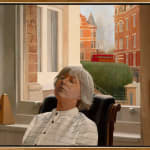Norman Blamey OBE RA (1914-2000)
A Bay Window in West Hampstead no.2
artist's label on verso with title
Oil on board
32.28 x 42.52ins (82 x 108 cm) (artwork size)
34.45 x 55.12 (87.5 x 140cm) (framed size)
34.45 x 55.12 (87.5 x 140cm) (framed size)
Copyright The Artist
Currency:
Norman Blamey was born in London, St Pancras in 1914, and studied at the Chelsea School of Art, where he became a senior lecturer from 1963 to 1979. He exhibited...
Norman Blamey was born in London, St Pancras in 1914, and studied at the Chelsea School of Art, where he became a senior lecturer from 1963 to 1979. He exhibited for the first time at the Royal Academy in 1938 and was elected as a Royal Academician in 1975. His paintings reflect his attachment to the Anglo-Catholic church and his interest in moments of quiet domestic scenes depicting his family.
The sitter in this painting is the artist’s wife, Margaret Kelly, one of his students he married in 1948 and with whom he had a son, the philosopher Stephen Blamey. Seated in a comfortable chair, she seems lost in her thought and impassive to the passing of time, highlighted by the metronome and the outside world to whom she turns her back. This quiet stillness, which invites reflection, is strengthened by the artist’s palette, made from smooth brown, white, and greys. A sweet tranquillity exudes from the painting, and the serenity of the human figure gives the scene a deep sense of spiritual peace, which is also present in Blamey’s depictions of church rituals. The realism of the city landscape and its geometrical aspect show the artist’s influence by early Flemish masters.
Blamey’s paintings are held in the collections of the Tate Gallery who acquired a number of his works, the United Kingdom Parliament, and the Southampton City Art Gallery.
The sitter in this painting is the artist’s wife, Margaret Kelly, one of his students he married in 1948 and with whom he had a son, the philosopher Stephen Blamey. Seated in a comfortable chair, she seems lost in her thought and impassive to the passing of time, highlighted by the metronome and the outside world to whom she turns her back. This quiet stillness, which invites reflection, is strengthened by the artist’s palette, made from smooth brown, white, and greys. A sweet tranquillity exudes from the painting, and the serenity of the human figure gives the scene a deep sense of spiritual peace, which is also present in Blamey’s depictions of church rituals. The realism of the city landscape and its geometrical aspect show the artist’s influence by early Flemish masters.
Blamey’s paintings are held in the collections of the Tate Gallery who acquired a number of his works, the United Kingdom Parliament, and the Southampton City Art Gallery.



